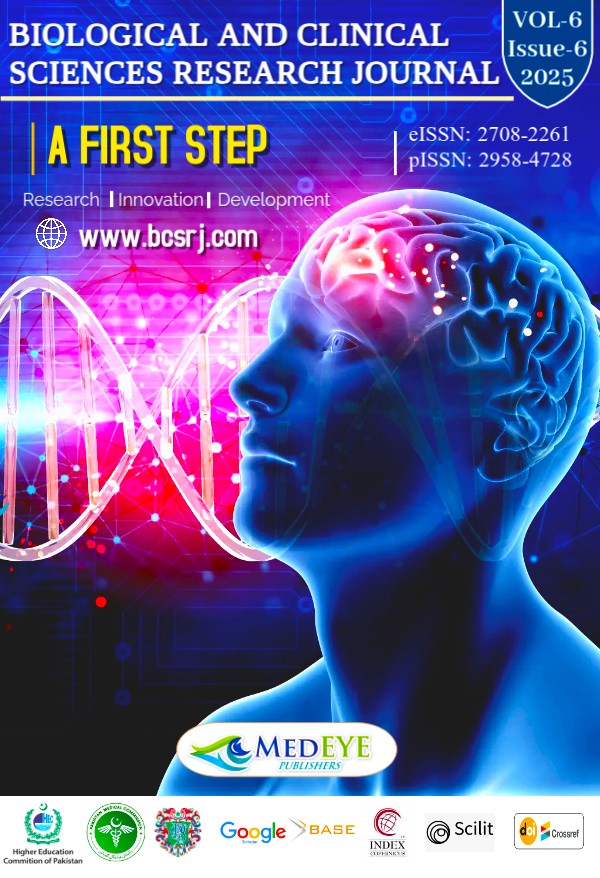The Effect of Port Site and Intra-Peritoneal Infiltration of 0.5% Bupivacaine as a Local Anesthetic on Post-Operative Analgesia in Patients Undergoing Laparoscopic Cholecystectomy under General Anesthesia
DOI:
https://doi.org/10.54112/bcsrj.v6i6.1949Keywords:
Bupivacaine, Laparoscopic Cholecystectomy, ERAS, Post-operative Pain, Nalbuphine, Opioid Consumption, RecoveryAbstract
Laparoscopic cholecystectomy (LC) is the standard surgical approach for gallbladder diseases. Despite advances in surgical techniques, post-operative pain remains a significant concern and is traditionally managed with systemic opioids, which are associated with adverse side effects. Multimodal strategies, including local anesthetic infiltration, are being explored to optimize analgesia and enhance recovery. Objective: This study aimed to evaluate the efficacy of 0.5% bupivacaine infiltration at port sites and intraperitoneally in reducing post-operative pain, opioid consumption, and enhancing early recovery after LC performed under general anesthesia. Methods: This randomized controlled trial was conducted at Combined Military Hospital, Jhelum, Pakistan, between July 2023 and December 2023. A total of 100 patients undergoing elective LC were randomly allocated to receive either port-site and intra-peritoneal infiltration of 0.5% bupivacaine (intervention group) or placebo (control group). Pain intensity was assessed using the Visual Analog Scale (VAS) at 2, 6, 12, and 24 hours postoperatively. Secondary outcomes included time to first ambulation, cumulative opioid consumption within 24 hours, and patient satisfaction using a 5-point Likert scale. Statistical analysis was performed using independent t-tests and chi-square tests, with a significance level of P < 0.05. Results: Patients in the intervention group reported significantly lower pain scores than the control group at all measured intervals (P < 0.05). At 24 hours, mean VAS scores were 2.1 ± 1.3 in the intervention group versus 4.6 ± 1.7 in controls (P = 0.002). The time to first ambulation was earlier in the intervention group (2.0 ± 0.5 hours) compared with the control group (4.0 ± 1.2 hours; P = 0.001). Total opioid use was significantly reduced in the intervention group (10.4 ± 3.2 mg) compared with controls (20.1 ± 7.8 mg; P = 0.001). Patient satisfaction scores were also higher in the intervention group (4.5 ± 0.5) compared to the control group (3.2 ± 0.8; P = 0.004). Conclusion: Infiltration of 0.5% bupivacaine at port sites and intraperitoneally provides adequate analgesia, reduces opioid requirements, accelerates mobilization, and improves patient satisfaction following LC. This approach represents a valuable adjunct to multimodal analgesia, supporting its integration into Enhanced Recovery After Surgery (ERAS) protocols.
Downloads
References
Bozic D, Ardalic Z, Mestrovic A, et al. Assessment of gallbladder drainage methods in the treatment of acute cholecystitis: a literature review. Medicina. 2024;60(1):5. https://doi.org/10.3390/medicina60010005
Mannam R, Sankara Narayanan R, Bansal A, et al. Laparoscopic cholecystectomy versus open cholecystectomy in acute cholecystitis: a literature review. Cureus. 2023;15(9):e45704. https://doi.org/10.7759/cureus.45704
Függer R. Challenging situations in cholecystectomy and strategies to overcome them. Eur Surg. 2021;53(3):106-13. https://doi.org/10.1007/s10353-020-00687-4
Dieu A, Huynen P, Lavand'homme P, et al. Pain management after open liver resection: Procedure-specific postoperative pain management (PROSPECT) recommendations. Reg Anesth Pain Med. 2021;46(5):433-45. https://doi.org/10.1136/rapm-2020-101933
Paul AK, Smith CM, Rahmatullah M, et al. Opioid analgesia and opioid-induced adverse effects: a review. Pharmaceuticals. 2021;14(11):1091. https://doi.org/10.3390/ph14111091
Ljungqvist O, de Boer HD, Balfour A, et al. Opportunities and Challenges for the Next Phase of Enhanced Recovery After Surgery: A Review. JAMA Surg. 2021;156(8):775-84. https://doi.org/10.1001/jamasurg.2021.0586
Young-Fadok TM. Perioperative pain management for abdominal operations. In: Romanelli JR, Dort JM, Kowalski RB, Sinha P, editors. The SAGES manual of quality, outcomes, and patient safety. Springer International Publishing; 2022. p. 311-34. https://doi.org/10.1007/978-3-030-94610-4_16
Stamenkovic DM, Bezmarevic M, Bojic S, et al. Updates on wound infiltration use for postoperative pain management: a narrative review. J Clin Med. 2021;10(20):4659. https://doi.org/10.3390/jcm10204659
Getachew M, Tesfaye H, Yihunie W, et al. Sustained-release local anesthetics for pain management: relevance and formulation approaches. Front Pain Res. 2024;5:1383461. https://doi.org/10.3389/fpain.2024.1383461
Koster JD, Deas DE, Palaiologou A, Lasho DJ, Diogenes A. Immediate postoperative anesthesia with either lidocaine or bupivacaine: a short-term clinical response. J Periodontol. 2025;96(2):1-8. https://doi.org/10.1002/JPER.25-0045
Grossi P. Enhanced recovery after surgery (ERAS) protocols in orthopaedic surgery: opioids or no opioids? J Pain Res. 2025;18:1683-95. https://doi.org/10.2147/JPR.S496891
Chen SS, Gao YM, Yao XF, et al. Effect of rapid rehabilitation surgical nursing on patients' gastrointestinal function recovery and sleep quality after laparoscopic appendectomy. World J Gastrointest Surg. 2025;17(4):102681. https://doi.org/10.4240/wjgs.v17.i4.102681
Zhang L, Wu Q, Wang X, Zhu X, Shi Y, Wu CJ. Factors impacting early mobilization according to the enhanced recovery after surgery guideline following gastrointestinal surgery: a prospective study. Geriatr Gerontol Int. 2024;24(2):234-9. https://doi.org/10.1111/ggi.14799
Peden CJ, Aggarwal G, Aitken RJ, et al. Guidelines for Perioperative Care for Emergency Laparotomy: Enhanced Recovery After Surgery (ERAS) Society Recommendations—Part 1: Preoperative—Diagnosis, Rapid Assessment, and Optimization. World J Surg. 2021;45(5):1272-90. https://doi.org/10.1007/s00268-021-05994-9
Fu G, Xu L, Chen H, Lin J. State-of-the-art anesthesia practices: a comprehensive review on optimizing patient safety and recovery. BMC Surg. 2025;25(1):32. https://doi.org/10.1186/s12893-025-02763-6
Downloads
Published
How to Cite
Issue
Section
License
Copyright (c) 2025 Hamna Asif, Muhammad Hanif Abbassi, Muhammad Ali Zar Qureshi, Muhammad Hamza Afzal

This work is licensed under a Creative Commons Attribution-NonCommercial 4.0 International License.








